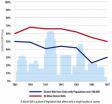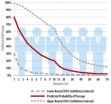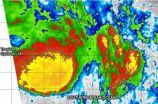No strength in numbers
Infighting undermines large cities in state legislatures
2014-02-10
(Press-News.org) Urban legislators have long lamented that they do not get their fair share of bills passed in state governments, often blaming rural and suburban interests for blocking their efforts. Now a new study confirms one of those suspicions but surprisingly refutes the other.
The analysis—of 1,736 bills in 13 states over 120 years—found that big-city legislation was passed at dramatically lower rates than bills for smaller places.
However, rural and suburban colleagues should not be blamed for the dismal track record, conclude co-authors Gerald Gamm of the University of Rochester and Thad Kousser of the University of California, San Diego. Instead, the researchers found that infighting within city delegations undermines legislative success.
"The data show that because of their large numbers, delegations from major cities like Chicago or New York are more likely to be at odds on legislation than smaller delegations, muddling cues for others in the chamber," explains Gamm. "After all, if the delegates from a city can't coalesce behind a bill, why should legislators from other parts of the state vote for the law?"
"If you talk to people from big cities, they will tell you that they are at a disadvantage in seeking legislation. Right now, for example, Bill de Blasio, the mayor of New York City, cannot raise taxes on his own city's residents to pay for prekindergarten programs unless the state legislature passes a law authorizing the new revenue stream. Similarly, Antonio Villaraigosa, who just stepped down as mayor of Los Angeles, had to persuade the California state legislature to grant him authority over the city's schools. This has been going on for more than a century," says Gamm.
But this stranglehold on cities in many ways is counterintuitive, points out Kousser. It goes against a basic tenet of democracy—that majorities matter. "The assumption is that the largest legislative blocs should have an outsized influence on decision making," says Kousser. "But when it comes to cities, those with the largest number of delegates enter the race handicapped."
Reported in the paper "No Strength in Numbers" in the American Political Science Review, the analysis is based on a study of so-called district bills, legislation that affects only a single locality or county. The researchers are the first to document the disappointing fate of big-city legislation and to test with hard data the reasons metropolitan areas are often stymied in state politics.
Through statistical analysis of district bills from 1880 to 2000, Gamm and Kousser explored common explanations for the legislative troubles of big cities. Could it be that metropolitan areas are doomed by party politics when the city and the hinterland support opposing parties? Could the sheer number of bills that larger communities generate lead to a sort of "bill exhaustion"?
Or maybe the problem is straight-up fear and animus: "The great narrative in urban politics has been a story of unremitting hostility," write the authors.
"For the past century or more, city delegates have believed that rural and suburban areas dreaded the city's dominance or were threatened by racial or ethnic differences," says Gamm.
Surprisingly, however, the researchers found little or no effect when controlling for each of these factors. Instead, the dramatic and consistent link to legislative success was delegation size: the larger the city delegation, the more its bills were doomed. As city delegates increase in number, they are less united and tend to divide more along party lines—undermining the ability of urban areas to pass legislation, explain the authors. For cities with populations over 100,000, that "special burden" translated into a 29 percent passage rate in 1997.
"We were astonished how consistent bill failure was based on size and also surprised that there was little evidence of hostility toward the city," says Gamm.
The researchers found that even the redrawing of states' voting districts in the 1960s, predicted to increase urban representation and influence, backfired because of the crippling effect of larger delegation size. During this period, states moved to ensure equal numbers of voters among districts, increasing the number of delegates from urban areas, which traditionally had been underrepresented. Ironically, legislation passage rates for metropolitan areas after the 1960s were the lowest since the nineteenth century. Though reapportionment gave "urban areas greater representation, it also saddled them with more representatives and thus increased the chances that their delegations might be internally divided," Gamm and Kousser write.
If numbers don't help, what should a city do? "The only advice I have is to work together," says Gamm. "City delegations need to broker compromise before they get to the floor of the state legislature. If they can compromise, if a big city delegation can agree on a bill, our prediction is that they will be successful. But if, for example, the Houston delegation is split, and some support and others fight a bill, the bill will fail."
INFORMATION:
This study and earlier findings are part of an ongoing analysis of 120 years of state legislation. The project builds on an extensive data set, originally funded by the National Science Foundation, that includes every district bill submitted in the lower house of 13 state legislatures: Alabama, California, Illinois, Massachusetts, Michigan, Minnesota, Montana, Nebraska, New York, Texas, Vermont, Virginia, and Washington. The chosen states reflect variations in region, urbanization, legislative professionalism, state incomes, racial and ethnic composition, and other factors.
ELSE PRESS RELEASES FROM THIS DATE:
Virtual avatars may impact real-world behavior
2014-02-10
How you represent yourself in the virtual world of video games may affect how you behave toward others in the real world, according to new research published in Psychological Science, a journal of the Association for Psychological Science.
"Our results indicate that just five minutes of role-play in virtual environments as either a hero or villain can easily cause people to reward or punish anonymous strangers," says lead researcher Gunwoo Yoon of the University of Illinois at Urbana-Champaign.
As Yoon and co-author Patrick Vargas note, virtual environments afford people ...
Huntington disease prevention trial shows creatine safe, suggests slowing of progression
2014-02-08
The first clinical trial of a drug intended to delay the onset of symptoms of Huntington disease (HD) reveals that high-dose treatment with the nutritional supplement creatine was safe and well tolerated by most study participants. In addition, neuroimaging showed a treatment-associated slowing of regional brain atrophy, evidence that creatine might slow the progression of presymptomatic HD. The Massachusetts General Hospital (MGH) study also utilized a novel design that allowed participants – all of whom were at genetic risk for the neurodegenerative disorder – to enroll ...
Stroke trigger more deadly for African-Americans
2014-02-08
ANN ARBOR, Mich. — Infection is a stronger trigger of stroke death in African- Americans than in whites, a University of Michigan study shows.
African-Americans were 39 times more likely to die of a stroke if they were exposed to an infection in the previous month when compared to other time periods while whites were four times more likely and Hispanics were five times more likely to die of stroke after an infection, according to the findings that appear online Feb. 7 in Neurology.
The most frequent infections were urinary, skin, and respiratory tract infections ...
Women fare worse than men following stroke
2014-02-08
WINSTON-SALEM, N.C. – Feb. 7, 2014 – The good news: More people survive stroke now than 10 years ago due to improved treatment and prevention.
The bad news: Women who survive stroke have a worse quality of life than men, according to a study published in the Feb. 7 online issue of the journal Neurology.
Researchers at Wake Forest Baptist Medical Center compared the quality of life in men and women who had a stroke or transient ischemic attack (TIA). A total of 1,370 patients ages 56 to 77 from the AVAIL registry – a national, multicenter, longitudinal registry of ischemic ...
New application of physics tools used in biology
2014-02-08
A Lawrence Livermore National Laboratory physicist and his colleagues have found a new application for the tools and mathematics typically used in physics to help solve problems in biology.
Specifically, the team used statistical mechanics and mathematical modeling to shed light on something known as epigenetic memory -- how an organism can create a biological memory of some variable condition, such as quality of nutrition or temperature.
"The work highlights the interdisciplinary nature of modern molecular biology, in particular, how the tools and models from mathematics ...
Social or stinky? New study reveals how animal defenses evolve
2014-02-08
When people see a skunk, the reaction usually is "Eww," but when they see a group of meerkats peering around, they often think "Aww."
Why some animals use noxious scents while others live in social groups to defend themselves against predators is the question that biologists Tim Caro of the University of California, Davis and Theodore Stankowich of California State University, Long Beach and sought to answer through a comprehensive analysis of predator-prey interactions among carnivorous mammals and birds of prey.
Their findings appear in the online edition of the ...
Endocrine Society calls for large-scale studies to evaluate testosterone therapy risks
2014-02-08
Chevy Chase, MD—According to a statement issued today by the Endocrine Society, the risks and benefits of testosterone therapy for older men with declining levels of the hormone need to be fully evaluated.
The statement comes in response to recent studies that have raised concerns about the safety of testosterone therapy in older men with a history of heart disease. Two retrospective analyses and one randomized trial supported by the Veterans Health Care System, and the National Institutes of Health found a higher rate of cardiovascular events in men who received testosterone ...
NASA spots very heavy rainfall rates in Tropical Cyclone Edilson
2014-02-08
Imagine receiving as much as 7 inches of rain in one hour. That's about what NASA's TRMM satellite spotted falling in one area within Tropical Cyclone Edilson as it moved over the Southern Indian Ocean.
The Tropical Rainfall Measuring Mission or TRMM satellite is managed by both NASA and the Japan Aerospace Exploration Agency called JAXA. TRMM can read the rate in which rain is falling on Earth while in its orbit high above.
The TRMM satellite had an excellent early morning look at Edilson on February 7, 2014 at 0237 UTC/06:28 local time when it passed directly above ...
Diaphragm pacing in spinal cord injury successful in weaning patients from ventilators
2014-02-08
CLEVELAND – A new study published in the Journal of Trauma and Acute Care Surgery finds that diaphragm pacing (DP) stimulation in spinal cord-injured patients is successful not only in weaning patients from mechanical ventilators but also in bridging patients to independent respiration, where they could breathe on their own without the aid of a ventilator or stimulation.
The stimulation is provided by the Diaphragm Pacing System (DPS), a technology providing electrical stimulation to nerves running through the diaphragm, the major muscle involved in breathing. When stimulated, ...
NASA spots fourteenth tropical cyclone of Southern Indian Ocean season
2014-02-08
The fourteenth tropical cyclone of the Southern Indian Ocean season was born as NASA's Terra satellite passed overhead.
On February 7 at 0900 UTC/4 a.m. EST, Tropical Cyclone 14S had maximum sustained winds near 35 knots/40 mph/62 kph. It was located about 814 nautical miles/936.7 miles/1,508 km east-northeast of Port Louis, Mauritius near 14.8 south and 70.4 east. At that time, 14S was moving to the south near 8 knots/9.2 mph/14.8 kph.
The Joint Typhoon Warning Center noted that multispectral satellite imagery showed that the low-level center is exposed to outside ...
LAST 30 PRESS RELEASES:
Interaction of climate change and human activity and its impact on plant diversity in Qinghai-Tibet plateau
From addressing uncertainty to national strategy: an interpretation of Professor Lim Siong Guan’s views
Clinical trials on AI language model use in digestive healthcare
Scientists improve robotic visual–inertial trajectory localization accuracy using cross-modal interaction and selection techniques
Correlation between cancer cachexia and immune-related adverse events in HCC
Human adipose tissue: a new source for functional organoids
Metro lines double as freight highways during off-peak hours, Beijing study shows
Biomedical functions and applications of nanomaterials in tumor diagnosis and treatment: perspectives from ophthalmic oncology
3D imaging unveils how passivation improves perovskite solar cell performance
Enriching framework Al sites in 8-membered rings of Cu-SSZ-39 zeolite to enhance low-temperature ammonia selective catalytic reduction performance
AI-powered RNA drug development: a new frontier in therapeutics
Decoupling the HOR enhancement on PtRu: Dynamically matching interfacial water to reaction coordinates
Sulfur isn’t poisonous when it synergistically acts with phosphine in olefins hydroformylation
URI researchers uncover molecular mechanisms behind speciation in corals
Chitin based carbon aerogel offers a cleaner way to store thermal energy
Tracing hidden sources of nitrate pollution in rapidly changing rural urban landscapes
Viruses on plastic pollution may quietly accelerate the spread of antibiotic resistance
Three UH Rainbow Babies & Children’s faculty elected to prestigious American Pediatric Society
Tunnel resilience models unveiled to aid post-earthquake recovery
Satellite communication systems: the future of 5G/6G connectivity
Space computing power networks: a new frontier for satellite technologies
Experiments advance potential of protein that makes hydrogen sulfide as a therapeutic target for Alzheimer’s disease
Examining private equity’s role in fertility care
Current Molecular Pharmacology achieves a landmark: real-time CiteScore advances to 7.2
Skeletal muscle epigenetic clocks developed using postmortem tissue from an Asian population
Estimating unemployment rates with social media data
Climate policies can backfire by eroding “green” values, study finds
Too much screen time too soon? A*STAR study links infant screen exposure to brain changes and teen anxiety
Global psychiatry mourns Professor Dan Stein, visionary who transformed mental health science across Africa and beyond
KIST develops eco-friendly palladium recovery technology to safeguard resource security
[Press-News.org] No strength in numbersInfighting undermines large cities in state legislatures





